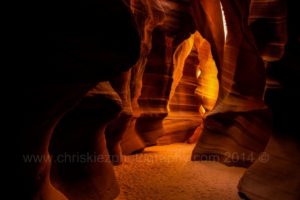Many people hold a special place in their hearts for the Grand Canyon and Antelope Canyon. Some also believe that they are the same. Horseshoe Bend is another favorite United States national treasure that can be confused for the two aforementioned canyons. However, these three spots are very distinct, with some important differences that everyone should know about. Read on to learn about the dissimilarities and common features of these three famous natural wonders.
Antelope Canyon
Antelope Canyon is located on Navajo land near Page, Arizona. It was formed by water running over smooth sandstone, a natural process that took place over many, many years. It is made up of two different slot canyons: Upper Antelope Canyon, or “the Crack,” and Lower Antelope Canyon, or “the Corkscrew.” Upper Antelope is well-known for its famous summer light beams and changing colors, and both locations are known for their unique natural features and rich history enmeshed with Navajo culture and southwestern United States desert geography. It is one of the most-photographed slot canyons in Arizona and the world. Check out these Antelope Canyon Photos.
Antelope Canyon is a sacred site of the Navajo Nation. As a result, it was named a Navajo Tribal Park in 1997 to give it the special protections that it deserves. Entering the Canyon is similar to entering a cathedral for the Navajo people. It is a symbol of the power and gifts of Mother Nature.
The Grand Canyon
At almost 300 miles long, the Grand Canyon is significantly longer and more expansive than Antelope Canyon. It contains more than one canyon, much like Antelope Canyon, but has several rather than just two. It is one of the seven natural wonders of the world and is one of the deepest gorges on planet Earth. The Grand Canyon has unique and interesting colors and geography like Antelope Canyon and was formed during a similar natural erosive process. It is also steeped in Native American history and is located within Arizona, giving it more commonalities with Antelope Canyon. With planning, Antelope Canyon and the Grand Canyon can be explored during the same trip.
Horseshoe Bend
Horseshoe Bend is another southwestern United States spot that is appreciated by many nature lovers. It is near the Grand Canyon and even closer to Antelope Canyon, but it is not a canyon itself. It is actually a meander of the Colorado River. Its interesting horseshoe shape gives Horseshoe Bend its name. Like the two canyons that have just been discussed, Horseshoe Bend got its beautiful shape from natural water erosion. It is also made of sandstone, much like Antelope Canyon. The Navajo Overlook at Horseshoe Bend is a private location of the Navajo people; further linking Horseshoe Bend and Antelope Canyon. Visit both landmarks during an Ultimate One Day Itinerary: Antelope Canyon and Horseshoe Bend.
Knowing about the similarities between these three locations and what makes each one unique helps every nature lover to be better-rounded culturally and better informed about the world around us. The next time someone you know asks you about one of these desert treasures, you will be able to share your knowledge and appreciation for all three. To learn even more about the history of Antelope Canyon, visit our website.

